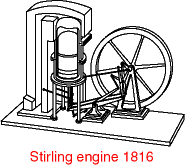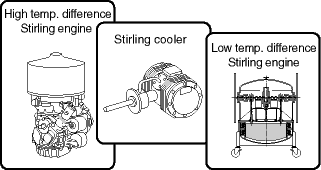|
Study on Design and Performance Prediction Methods for Miniaturized Stirling Engine
Background of research

 Background of research
Background of research
 The Stirling engine was invented by R. Stirling on 1816. At that time, the Stirling engines were recognized as a safe engine that could not explode like steam engines. But the Stirling engine had been made a poor production, in the back of Otto engine and Diesel engine.
The Stirling engine was invented by R. Stirling on 1816. At that time, the Stirling engines were recognized as a safe engine that could not explode like steam engines. But the Stirling engine had been made a poor production, in the back of Otto engine and Diesel engine.
The Stirling engine had been started to develop rapidly with effect of oil-shock in 1973. Still more, energy and environment problems have become one of the most important social problems at present. Then the Stirling engine is being noticed now.
The reasons are;
(1) High thermal efficiency,
(2) A great variety of the fuel,
(3) Low emission and low pollution.
Recently, the energy and environment problems have become the most serious social problems. We should not continue to use the internal combustion engines which have big emission and pollution. So, the low emission engine is required. The Stirling engine can correspond to such request.
 There are several types of the Stirling engines (Stirling cycle machines) as shown in a right figure. The Stirling engines are being researched and developed lively in the world. Especially the Stirling cooler using an opposite cycle is used practically in part. A prototype engine which is developed in this reseach is one of the high temperature difference Stirling engines.
There are several types of the Stirling engines (Stirling cycle machines) as shown in a right figure. The Stirling engines are being researched and developed lively in the world. Especially the Stirling cooler using an opposite cycle is used practically in part. A prototype engine which is developed in this reseach is one of the high temperature difference Stirling engines.
 Outline of developments related high temperature difference Stirling engines
Outline of developments related high temperature difference Stirling engines
As the developments related the high temperature difference Stirling engines, the Stirling machines for air conditioners were studyed and developed by a Japanese Moon-Light project on 1982. Then, it became clearly that the Stirling engine has high efficient and low pollution characteristics. But the Stirling engine has not reached practical use yet, because the engine has several problems, which are a high production cost, an endurance of a no-lublicate seal device and a smaller power per the engine weight.
As the Stirling engine for the generator, Philips Co. (the Netherlands) developed portable-type Stirling gererator sets for military use. They had not spread in these days, though 150 of the gererator sets were produced.
Recently, Wisper GEN Co. (New Zealand), SOLO Co. (Germany) and SIGMA Co. (North Europe) have researched and developed the several kilo-wattage class Stirling gererator sets, though they are not portable type.
 Purpose of this research
Purpose of this research
We need an electic power in our life. Recently, the internal combustion engines are being used the electric generators. But the internal combustion engines must not be continued to use by above reasons.
A purpose of this research is a development of a small and light weight Stirling engine which is used to drive the portable type generator set, though there are many types of the application and power level for the generator sets.
 Probrems for developments of the compact Stirling engine
Probrems for developments of the compact Stirling engine
Probrems for developments of the compact Stirling engine are follows.
As the problems about a component technology, there are;
(1) Development of high efficient and compact heat exchangers,
(2) Development of a compact crank mechanism with a small mechanical loss.
This research has suggested follows in order to solve the problems.
(1) Adoption of an original engine structure to miniaturize,
(2) Proposal of an unique type heat exchanger for the compact engine,
(3) Adoption of a Scotch-yoke mechanism to miniaturize the engine.
As the problems about an analysis method, there are;
(1) Estimation of a engine performance and thermal loss accompanied by the compact engine,
(2) Accurate estimation of the mechanical loss.
This research has suggested follows in order to solve the problems.
(1) Estimation of a buffer loss, which is the thermal loss in a back space of the power piston,
(2) Easy and accurate prediction of the mechanical loss.
|  Background of research
Background of research Outline of developments related high temperature difference Stirling engines
Outline of developments related high temperature difference Stirling engines Purpose of this research
Purpose of this research Probrems for developments of the compact Stirling engine
Probrems for developments of the compact Stirling engine
 The Stirling engine was invented by R. Stirling on 1816. At that time, the Stirling engines were recognized as a safe engine that could not explode like steam engines. But the Stirling engine had been made a poor production, in the back of Otto engine and Diesel engine.
The Stirling engine was invented by R. Stirling on 1816. At that time, the Stirling engines were recognized as a safe engine that could not explode like steam engines. But the Stirling engine had been made a poor production, in the back of Otto engine and Diesel engine. There are several types of the Stirling engines (Stirling cycle machines) as shown in a right figure. The Stirling engines are being researched and developed lively in the world. Especially the Stirling cooler using an opposite cycle is used practically in part. A prototype engine which is developed in this reseach is one of the high temperature difference Stirling engines.
There are several types of the Stirling engines (Stirling cycle machines) as shown in a right figure. The Stirling engines are being researched and developed lively in the world. Especially the Stirling cooler using an opposite cycle is used practically in part. A prototype engine which is developed in this reseach is one of the high temperature difference Stirling engines.